Mexico’s Yucatan: Discovering an Ancient World in Modern Times
January 1, 2016
Ashley Lyn Olson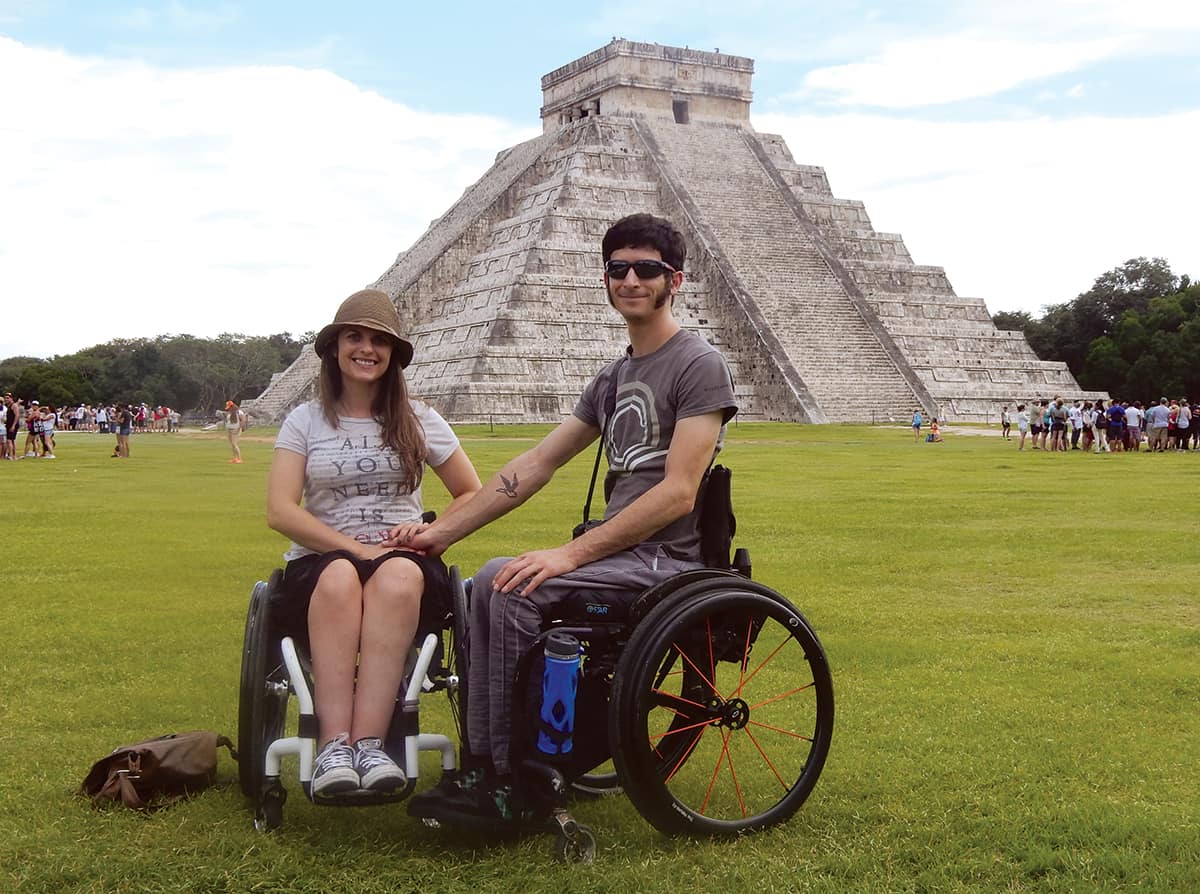
People come from all over the world to soak up the year-round sun on Mexico’s Yucatan Peninsula. Besides the turquoise waters, warm inviting climate and delicious food, what drew me and my boyfriend to this part of the world were the historical ruins of one of the world’s oldest known civilizations, the Maya. Their ancient sites, mostly located in the north-central part of the Yucatan Peninsula, have been uncovered and carefully preserved. But our trip began in Cancun on the beautiful Caribbean coast of Quintana Roo, Mexico’s easternmost state.
The Hotel Zone
Upon arriving at the Cancun airport in early November, we were greeted warmly by Cancun Accessible, a private tour company that serves the Cancun area, Riviera Maya, Puerto Morelos, Tulum, Playa del Carmen, Akumal, and most of the Yucatan Peninsula. For accommodations I selected the Westin Lagunamar Hotel on a narrow strip of sand known as the “Hotel Zona,” where you will find hotel after hotel mixed with shopping areas and restaurants. The Mayan Museum and Cancun Aquarium are also located on this strip. Many curb ramps have been installed in this tourist area, but they’re not everywhere. Many entrances were not accessible, so be forewarned.

Modern Cancun began in the 1970s as a government-funded project to lure tourists to the area. In 2005 Hurricane Wilma destroyed nearly all of the hotels, many of which have been successfully rebuilt. The Westin Lagunamar is one of the rebuilt hotels and is the only one along the beach that is equipped with a pool lift. Disappointingly, there was no balcony access in any of the rooms and no beach access from the hotel.
Downtown Cancun is a 15 to 20 minute drive from the Hotel Zona, and that’s where you’ll find the Four Points Sheraton Hotel — the only other hotel with a pool lift. In addition to the Westin Lagunamar, the other hotels that have barrier-free entrances into their pools are the Secrets Playa Mujeres Golf & Spa Resort, the Occidental Grand Xcaret Resort, and the Grand Bahia Principe.
Chichen Itza
Following our stay in Cancun, we headed to Chichen Itza — the ruins of one of the largest Mayan settlements, one of the Seven Wonders of the World and my primary reason for coming to the Yucatan Peninsula. A few small historical sites are located within urban areas, but the major ones require traveling a good distance into the jungles of the peninsula. For decades these world treasures have been nearly unreachable for wheelchair travelers, but now Cancun Accessible does all it can to make touring this area possible. Currently the company has three wheelchair accessible vans that can transport six wheelchair users and nine companions at the same time. Their vans are spacious and provide ample head room with tie-downs for wheelchairs and seatbelts, but they have not been lowered, so the ramps into the vehicles are steep. However, the driver is always able to assist with a push. Cancun Accessible set up an excellent tour of the excavated structures that highlighted how much is still covered by the jungle — and how much we do not know.
The highlight of Chichen Itza is the iconic pyramid called El Castillo, used for many Mayan cultural and religious purposes. Today, in an effort to preserve the landmark structures, people are not permitted on all the major archeological sites, so everyone gets the same ground-floor view, including wheelchair users — no one is allowed on the stairs. Despite lacking modern day telescopes and technology, the Mayans possessed a depth of knowledge about the universe, and many think they used this knowledge to build and place the structures of Chichen Itza. Spring and fall equinoxes draw the most tourists, who come to marvel at the play of light and shadow that make it seem as if a cosmic diamond-back snake is moving down the stairway of El Castillo. A guided tour showing the many details and explaining the history is highly recommended.
The generally flat landscape at Chichen Itza made getting around doable for manual wheelchair users and no problem for those who use power chairs, but there are some areas of caution. Designated parking is offered and the entrance fee is determined by one’s physical mobility. Since we use manual wheelchairs, we got in free because parts of the pathways present some challenges. The majority of the area was very firm and easy to navigate over. Local vendors selling hand-carved arts and crafts are everywhere.
Across from the ticket office at Chichen Itza is the beautiful Posada Hotel. The area around the hotel is paved and the hotel itself is a good place to eat while visiting Chichen Itza. Ramps allow you to move through the hotel to the buffet dining area where you can sample Mayan, Mexican and international foods. The taco stand with fresh, handmade tortillas was our favorite; hotel staff is all around to assist carrying your plate if needed. The dining room has an enormous patio for seating and a partially enclosed space with beautiful stained-glass windows where you can watch frequent dance performances.
The most unfortunate aspect of Chichen Itza is the lack of an accessible bathroom. I found the two sets of women’s bathrooms to be too small for my 22-inch wide manual wheelchair, but the men’s bathroom on the patio was just big enough for me to get in and close the door. However, there were no modifications and space was very tight.
Tulum
About two hours east of Chichen Itza, perched on Mexico’s stunning Caribbean coast, sit the Mayan ruins of Tulum. It is said that Tulum was built to protect the Mayan people against invaders but was also used as a key trading post for merchants with access to the land and sea routes. The most famous structure is a clifftop watchtower, also called El Castillo. Like Chichen Itza, the price of admission was determined by a person’s physical mobility, so once again we got in free. I found this reasonable considering that the hilly and sandy terrain of Tulum poses challenges for some wheelchair users. The information center by the parking lot has a special wide-tired wheelchair you can borrow for free.
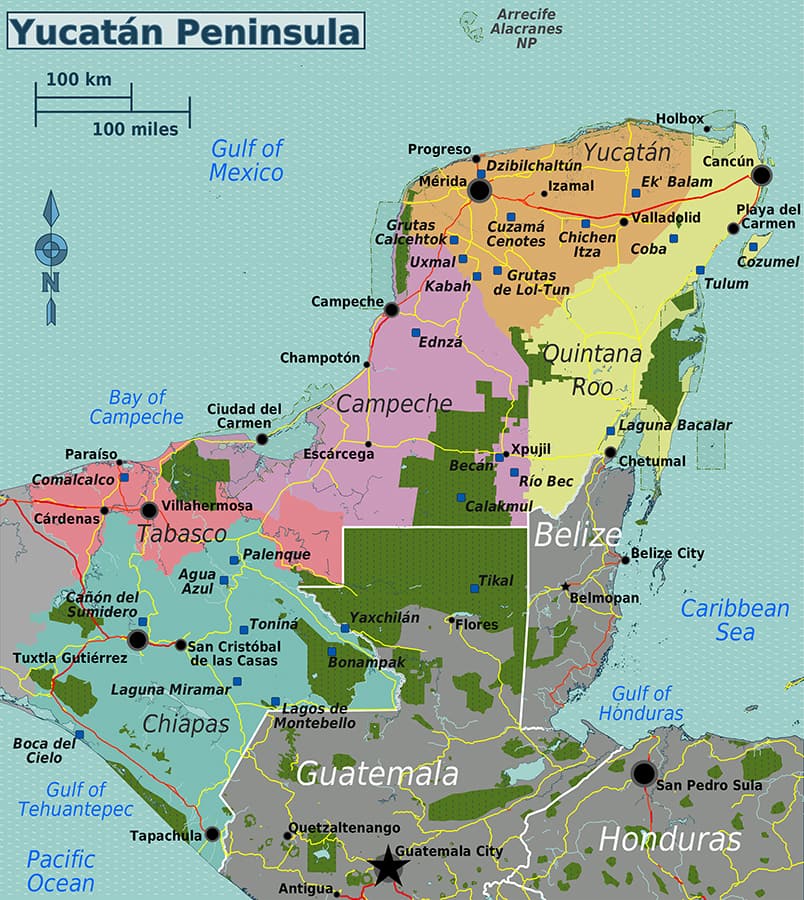
From the parking lot, it is a good 10 to 20 minute stroll to the archeological site. Along the way you will pass a few tourist shops and restaurants. Flooding can make navigating the mix of cobblestones, bridges, ramps and a tunnel tricky for wheelchairs; we had to be carried over parts. Only a few areas and pathways can be fully accessed by a wheelchair, due to deep sand barriers; one in particular takes you to a small beach cove below the Castillo and another directly in front of it. Tulum is still worth visiting to explore the details in some of the standing structures, but it is a lot easier for manual wheelchair users.
Again, the biggest challenge is the bathroom. At the gate there is a set of men’s and women’s bathrooms. The women’s was small and only permitted a side transfer. There were grab bars and a foot petal flush; however, power chairs wouldn’t fit.
Swimming with Dolphins
After Tulum we made our way to El Dorado Maroma, a resort about an hour away, to swim with dolphins. In Mexico there are a plethora of companies offering the opportunity to swim with dolphins. However, according to Cancun Accessible, Dolphin Discovery has the best overall experience and treatment of their animals, including an enclosed habitat in the actual ocean.
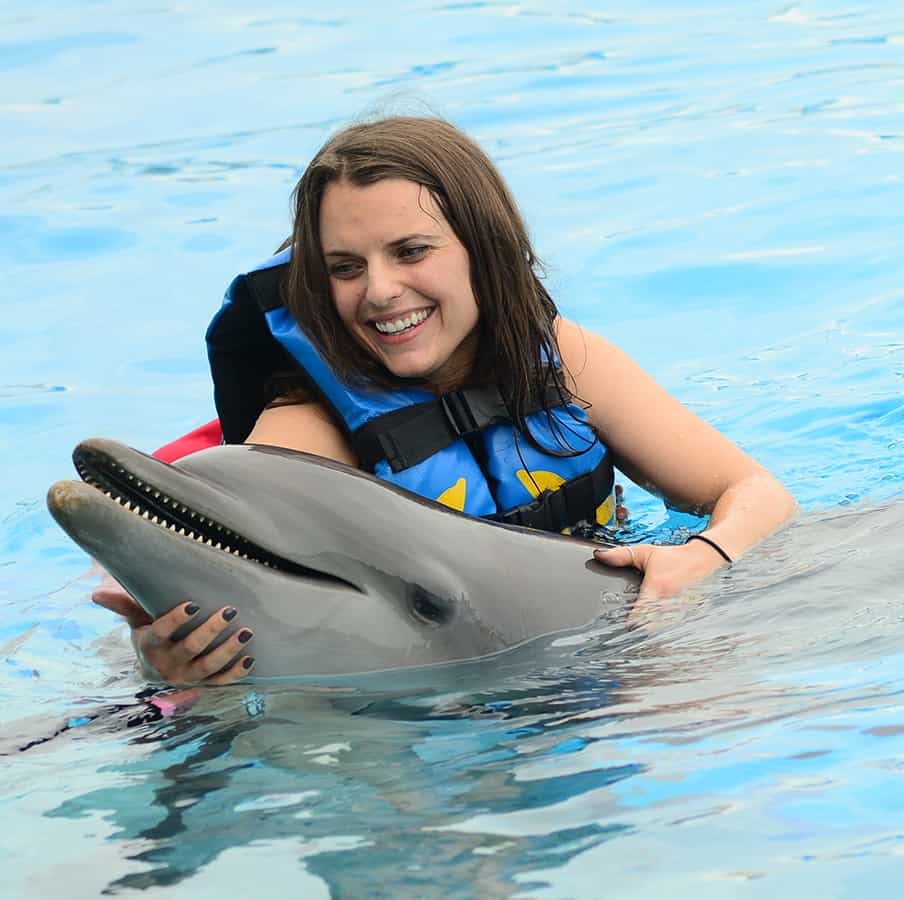
Getting to the saltwater pool from the parking lot was easy using the very smooth paved asphalt pathways. Not counting the ramp up to the pool deck, the ramps were not too steep. Dolphin Discovery is equipped with a beach wheelchair that takes you from the pool deck down a ramp into the pool. Lifejackets are put on every visitor, and Dolphin Discovery provides a person in the pool with you for extra assistance. Three different packages are offered, depending on how much interaction with the dolphins you want and what’s physically possible. We got to touch and kiss the dolphins a lot, but just being in the water with them brought an incredible feeling of joy.
One inaccessible lowlight was that the changing rooms and the bathrooms were not wheelchair accessible. We secretly changed into our swimsuits at a cabana next to the pool deck, which was not accessible and not entirely closed off. We got back into our clothes in the men’s main locker room area while our driver stopped anyone from coming in; the main entrance had no door. The women’s locker room was way too revealing for people passing by. We made it work but it is definitely a detail to be aware of.
Beach Life
After the dolphin swim we made a quick visit to the nearby beach area, Playa del Carmen. There are thousands of miles of beaches in Mexico, and some of the best are along the Caribbean coast.
Playa del Carmen, which lies between Tulum and Dolphin Discovery, is a great place to start. Fifth Street is where most of the shops and restaurants are located. It is colorful and definitely worth visiting. Some restaurants have access but, as seen throughout Mexico, most shops have one step. A small hill leads down to the ocean with women selling fresh fruit and other tropical items; getting back up the hill requires a good push for manual wheelchair users.
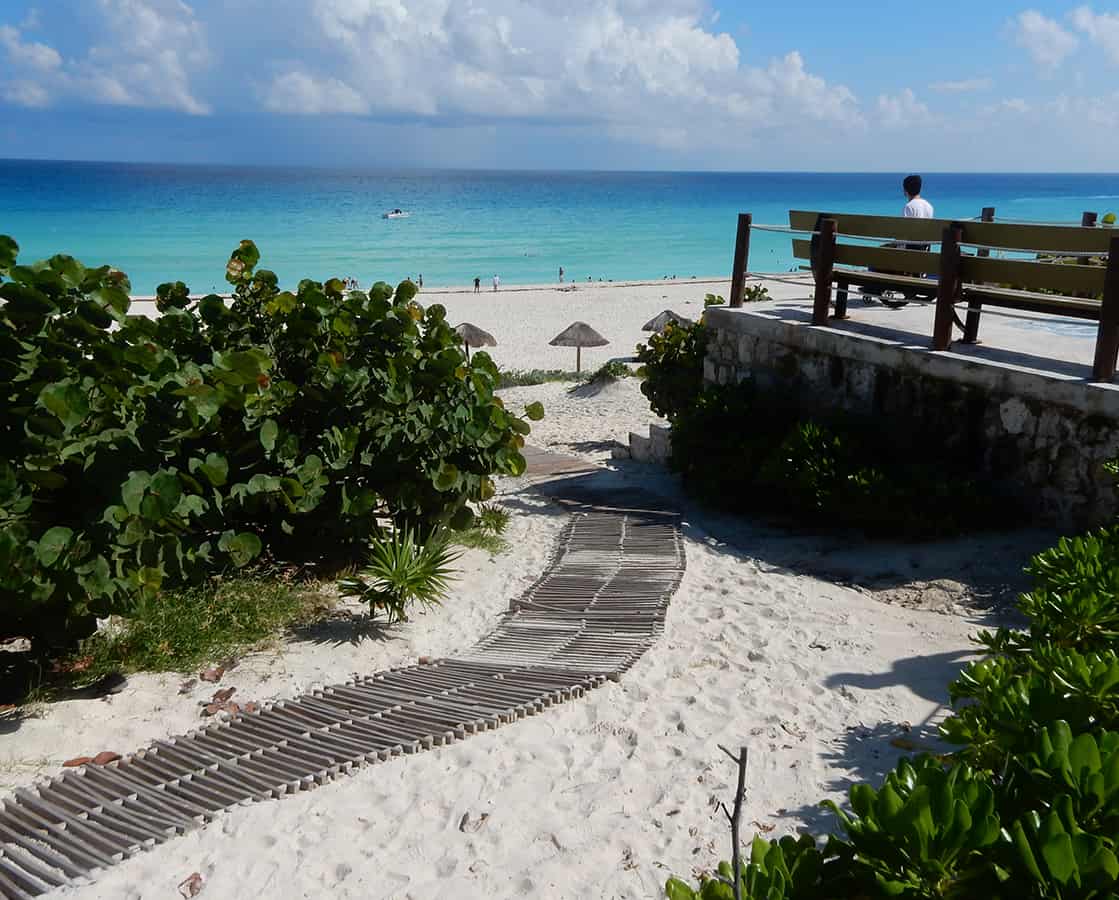
Just beyond the sand you can find the Portal Maya (The Mayan Gateway), a famous sculpture designed by José Arturo Tavarez. You can’t miss it. It towers into the sky and is the site of regularly scheduled traditional dances with ceremonial dress and music. The sculpture marks the entrance to Playa Fundadores. There’s another beach nearby called Playa Punta Esmeralada. Playa Fundadores has accessible bathrooms and showers and 15 to 20 beach wheelchairs you can borrow for free, thanks to Playa Inclusiva, a government accessibility program.
At one of these accessible beaches we met Inez Gonzales, a power chair user who moved to Playa del Carmen from Spain about four months ago. Having recently gone scuba diving with whale sharks, she told us about a company in Playa del Carmen that assists people in wheelchairs with scuba diving — Love to Make Bubbles Underwater. They can train and get you out to sea in one day. Playa Fundadores in Playa del Carmen is also close to the dock where a ferry takes visitors to the island of Cozumel. Lifewaters.org, a U.S.-based nonprofit that trains people with disabilities to dive, offers extensive packages there. Cozumel has an airport along with places to stay, eat, sleep, and enjoy the beach life. It is especially known for its clarity of water and scuba diving.
Besides Playa del Carmen, the other accessible beach in the area is Playa Delfines, by the Hotel Zona and the Cancun airport. A little more than two years ago a storm damaged the pathway to Playa Delfines, and when we were there, it still needed significant repairs. The pathway starts at the parking lot with several designated spaces and leads to a set of cabanas specifically designated for those with limited mobility. A few bathrooms are accessible along the quarter-mile paved promenade and are often locked, but a guest services employee at one of the regular bathrooms can unlock it. These were the most spacious bathrooms I saw on my trip, big enough for any chair and/or changing in and out of a swimsuit.
In the Hotel Zona and many other areas, you can rent jet-skis and parasail off the back of a boat. There are no modifications made, but for some travelers these activities may be possible. Fashion Harbor Mall in the Hotel Zona rents boats and less accessible water options.
Another option is to explore one of the area’s many resort parks, which offer everything from snorkeling to zip lines, inner tubes and much more — all with the goal of soaking up the sandy white beaches and crystal clear water. The most accessible options are Xel-Ha and Xcaret. The two are about an hour and a half away from each other. Of the two, Xcaret has more options with access. Like the archeological sites, these parks also discount tickets based on a person’s physical mobility — determined only in-person to prevent fraud. Even if an attraction is semi-accessible, ask for a discount. We did at the aquarium on Fashion Harbor in Cancun and got 50 percent off even though it was pretty much entirely accessible.
Underground Worlds of Water
Our tour guide told us there are 14,000 known cenotes (water wells or sinkholes) in the Yucatan Peninsula area, but more certainly exist. Cenotes are natural sinkholes that expose underground rivers. Some are considered to be sacred spaces, while others are used as town drains during rainfall. Most cenotes are inaccessible for wheelchair travelers, but some can be viewed from the surface, like Ik Kil — perhaps the most famous one in Mexico — located near Chichen Itza.
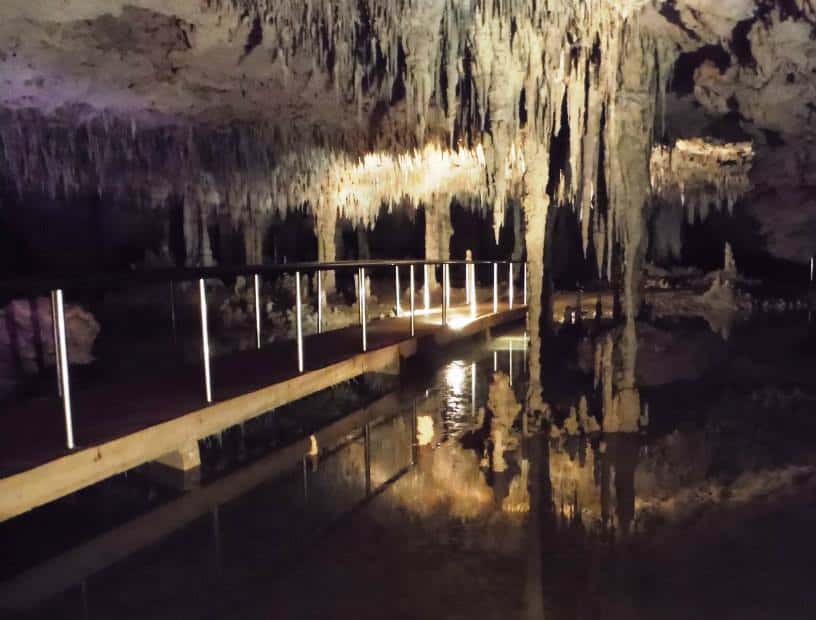
An incredible way to experience a cenote and the underground rivers is the Rio Secreto, a tour of cenotes and underground waterways just west of Xcaret. After a 15-minute drive deep into the jungle to the entrance of the cave, a guide performs a five-minute ritual to ask the universe permission to enter. Everyone then strolls about 10 more minutes to reach the cave’s paved ramp. About 15 minutes are spent exploring the cave’s stalactites and stalagmites with the guide, followed by a short movie.
Fiesta on the Water
For the first time, Cancun Accessible decided to include a unique dinner on a boat through the jungle with a company called Xoximilco. The night consists of lots of eating and drinking with live music, starting at the reception area before boarding the boats. This area is smoothly paved with a large accessible bathroom. A side ramp allows wheelchair guests to get to the boat dock. Everyone else on the boat gets on first, then the crewmen stand at the front of the boat to make it level with the dock to just roll right on. Chairs were removed upon request to remain in your wheelchair. The slope to the dinner table was short and required a bit of finesse to navigate.
Every boat has a guide to explain things and also encourage people to party. The whole experience is about three hours long. Once on the boat, the meal showcasing traditional Mexican food begins. Tequila is offered along with beer, soft drinks, and water — all you can drink. As the boat flows on along with other party boats, stops are made at parked boats for food service and entertainment. The dark river and surrounding jungle make every turn a mystery. Cactus, different meats and treats were offered as samples and served directly to us without our having to leave the table. Once we got our next course, the following stop would be at a boat with live band playing Mexican music. At the halfway point guests can get out, drink more alcohol, check out the gift shop, or use the restroom — one of which was modified for wheelchair access. The remaining ride continues with more music over dessert and coffee. It was an impressive production, like a Disneyland ride that replicates a Mexican dinner and show.
Resources:
• Playa del Carmen, 888/537-9797; www.playadelcarmen.com/hotels
• Chichen Itza, www.chichenitza.com
Swimming with Dolphins:
• Dolphin Discovery, 866/393-5158; www.dolphindiscovery.com
Scuba:
• Love to Make Bubbles Underwater; www.facebook.com/Love-to-make-bubbles-underwater
• Lifewaters.org, www.lifewaters.org
Tour and Transportation Companies:
• For Handicap Travelers, 52-998-251-5385; www.forhandicaptravelers.com/transportation.htm
• Cancun Plus, 866/800-0570; www.cancunplus.com/disabled-transportation-services.html
• AdaptA, 800/223-2782; www.adapta.com.mx. Click on the U.S. flag for English.
Access in General: Eating, Bathrooms, Ramps

Access to bathrooms is the biggest infrastructure improvement needed in the Yucatan Peninsula. In developed areas you really don’t need to go that far to find an accessible bathroom, but rural parts are much more challenging. Even American chain restaurants can’t be relied on for always being accessible.
Commonly, shops have a step or two inside, even at the nicest shopping areas. More restaurants than shops seemed to have ramp access. Sidewalks may end abruptly due to a barrier or lack of a curb-cut. Sometimes riding in the street may be the best way to get around, but can be risky. Designated parking spaces for wheelchairs exist but do not have the crosshatch space to get in and out.
Starting Off With a Shaman Cleanse

My first full day in Mexico was a day I’ll never forget. After watching a glorious sunrise, we left our hotel for a date with a shaman at the Jardines del Colibri Dorado in Sisbicchén, Yucatan. Translated literally, Jardines del Colibri Dorado means the Gardens of the Golden Hummingbird. It is a beautiful ranch that is impossible to find unless you know where you are going. We had no idea what to expect and neither did the tour company; it was a new exploration for all of us and the first time someone requested seeing a shaman. We were greeted by a few friendly dogs and four healers, including the shaman known as Abuelo (grandfather) Antonio. We connected immediately. Following Abuelo Antonio into the barrier-free meditation room, we talked while drinking water from a sacred cenote (water well) over Santa Maria before the main part of the ceremony.
Once it was time, we lay on a massage table and received our treatment. Specific candles were lit next to burning incense. The shaman explained that incense grounds us and nourishes the earth (ashes), and the smell (smoke) is a gift for the heavens. Different oils were rubbed onto our skin and prayers were whispered as a special kind of acupuncture was performed. Each session was customized, and sometimes all four healers were working simultaneously on me. At one point the skylight painted rainbows on our skin. After the treatment we remained on the tables for a good while in a deep meditation, feeling the vibrational frequencies flow. I snapped out of it upon hearing the shaman quietly tell our driver and guide that we were almost finished. When I was finally able to move, I felt as light as air and embraced the shaman with a long, loving hug.
Costs and Getting Around
Costs vary widely depending on time of year. May to November is the most affordable window, especially September and October, the rainy (and sometimes hurricane) season. The expensive season runs from the end of November to early March — during the holiday season and the best weather. If you can plan to go during a “shoulder season” — early December or April — you can get the best combination of prices and weather.
Low season airfares generally run between $300-$450 per person from any major U.S. airport. Fly during Christmas week and your cost will just about double. Accommodations in the Cancun area are likely to follow the same pattern, but costs depend mostly on the rating of the hotel or resort. In April prices range from as little as $50/night for a two-star hotel to $700/night or more for a five-star resort. It pays to do a lot of research to pin down the best deal at the quality you can afford.
Cancun Accessible Tours can pick you up at the Cancun Airport in an accessible van with tie-downs and drop you off at your hotel, but once there, accessible transportation becomes a problem. You can arrange for Cancun Accessible to take you on tours, but they can be expensive, and the only other way you can travel in a wheelchair is in a rental car with no hand controls, or perhaps an accessible taxi. If you choose Cancun Accessible for touring, the more people in your party, the cheaper the cost per person. A day trip to Chichen Itza might cost $297 per person for two people but $187 per person for a group of four and even less for five or six. A three-day tour that includes Chichen Itza, Tulum and Swimming with Dolphins ranges between $430 to $750 per person, depending on the group size.
To sum up, a weeklong vacation for two near Cancun at a three-star hotel in the low or shoulder season (including airfare) will run between $2,000-$4,000, depending on where you eat and how much time you spend hanging out at the hotel pool and/or day-tripping from location to location.
Support New MobilityWait! Before you wander off to other parts of the internet, please consider supporting New Mobility. For more than three decades, New Mobility has published groundbreaking content for active wheelchair users. We share practical advice from wheelchair users across the country, review life-changing technology and demand equity in healthcare, travel and all facets of life. But none of this is cheap, easy or profitable. Your support helps us give wheelchair users the resources to build a fulfilling life. |



Recent Comments
DINOS PITSILLIDES on Functional Fitness: How To Make Your Transfers Easier
Stosh on Functional Fitness: How To Make Your Transfers Easier
Bill on LapStacker Relaunches Wheelchair Carrying System